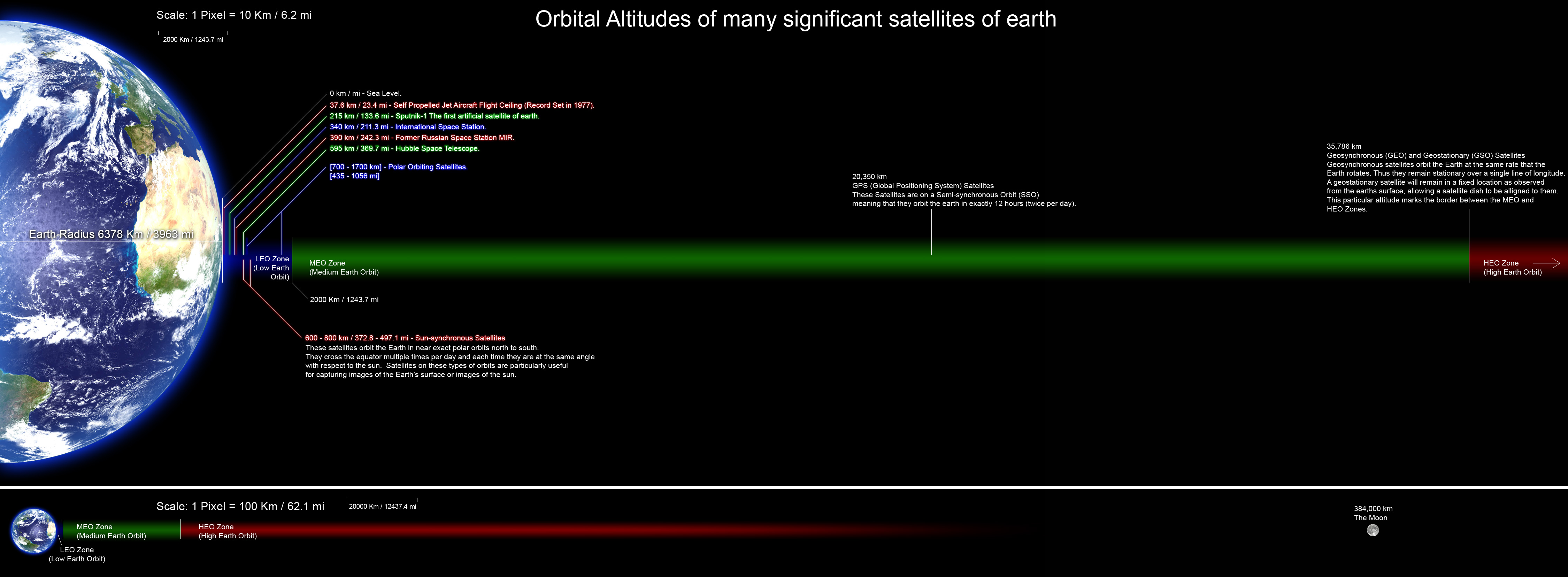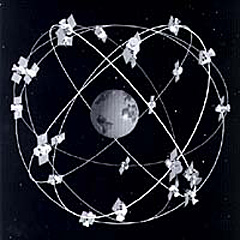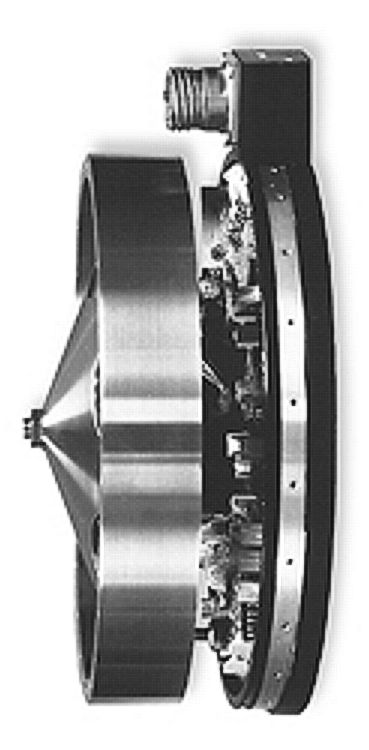|
USA-35
USA-35, also known as Navstar 2-01, GPS II-1 and GPS SVN-14, was an American navigation satellite which formed part of the Global Positioning System. It was the first of nine Block II GPS satellites to be launched, which were the first operational GPS satellites to be launched. Background It was one of the 21-satellite Global Positioning System (GPS) Block II series. When complete, the constellation will provide precise position data (accurate to within 16 m) to military and civilian users worldwide. Navstar signals can be received on devices as small as a telephone. The new generation Delta is 4.2 m taller and 13% more powerful than its predecessor. It can boost 3,982 kg into low Earth orbit, 1,447 kg into geotransfer orbit. The GPS II satellites, built by Rockwell International for Air Force Space Systems Division, each have a 7.5-year design life. The Air Force intends to launch a GPS II every 2 to 3 months until the constellation of 21 operational satellites and 3 ... [...More Info...] [...Related Items...] OR: [Wikipedia] [Google] [Baidu] |
Delta II
Delta II was an expendable launch system, originally designed and built by McDonnell Douglas. Delta II was part of the Delta rocket family and entered service in 1989. Delta II vehicles included the Delta 6000, and the two later Delta 7000 variants ("Light" and "Heavy"). The rocket flew its final mission ICESat-2 on 15 September 2018, earning the launch vehicle a streak of 100 successful missions in a row, with the last failure being GPS IIR-1 in 1997. History In the early 1980s, all United States expendable launch vehicles were planned to be phased out in favor of the Space Shuttle, which would be responsible for all government and commercial launches. Production of Delta, Atlas-Centaur, and Titan 34D had ended. The ''Challenger'' disaster of 1986 and the subsequent halt of Shuttle operations changed this policy, and President Ronald Reagan announced in December 1986 that the Space Shuttle would no longer launch commercial payloads, and NASA would seek to purchase launches ... [...More Info...] [...Related Items...] OR: [Wikipedia] [Google] [Baidu] |
USA Satellites
This is a list of satellites and spacecraft which have been given USA designations by the United States Air Force. These designations have been applied to most United States military satellites since 1984, and replaced the earlier OPS designation. As of June 2022, USA designations have been assigned to 331 space satellites. There is not always a one-to-one mapping between launch vehicles and mission spacecraft. This can occasionally result in gaps when maintaining records that incorrectly make that assumption, such as the "missing" entries for USA-163 (which are, symmetrically, contemporary with confusion over "splitting" spacecraft tracks). List See also * List of NRO launches References External links Directory of U.S. Military Rockets and Missiles - Satellite Launch ListEncyclopedia Astronautica {{Space exploration lists and timelines USA The United States of America (U.S.A. or USA), commonly known as the United States (U.S. or US) or America, is a cou ... [...More Info...] [...Related Items...] OR: [Wikipedia] [Google] [Baidu] |
USA-150
USA-150, also known as GPS IIR-4 and GPS SVN-51, is an American navigation satellite which forms part of the Global Positioning System. It was the fourth Block IIR GPS satellite to be launched, out of thirteen in the original configuration, and twenty one overall. It was built by Lockheed Martin, using the AS-4000 satellite bus. Launch USA-150 was launched at 01:48:00 UTC on 11 May 2000, atop a Delta II carrier rocket, flight number D278, flying in the 7925-9.5 configuration. The launch took place from Space Launch Complex 17A at the Cape Canaveral Air Force Station, and placed USA-150 into a transfer orbit. The satellite raised itself into medium Earth orbit using a Star-37FM apogee motor. Mission By 11 June 2000, USA-150 was in an orbit with a perigee of , an apogee of , a period of 718.02 minutes, and 54.9° of inclination to the equator. It is used to broadcast the PRN 20 signal, and operates in slot 1 of plane E of the GPS constellation, having replaced USA-35 USA ... [...More Info...] [...Related Items...] OR: [Wikipedia] [Google] [Baidu] |
USA-10
USA-10, also known as Navstar 11, GPS I-11 and GPS SVN-11, was an American navigation satellite launched in 1985 as part of the Global Positioning System development programme. It was the last of eleven Block I GPS satellites to be launched. Background Global Positioning System (GPS) was developed by the U.S. Department of Defense to provide all-weather round-the-clock navigation capabilities for military ground, sea, and air forces. Since its implementation, GPS has also become an integral asset in numerous civilian applications and industries around the globe, including recreational used (e.g., boating, aircraft, hiking), corporate vehicle fleet tracking, and surveying. GPS employs 24 spacecraft in 20,200 km circular orbits inclined at 55°. These vehicles are placed in 6 orbit planes with four operational satellites in each plane. Spacecraft The first eleven spacecraft (GPS Block 1) were used to demonstrate the feasibility of the GPS system. They were 3-axis stabili ... [...More Info...] [...Related Items...] OR: [Wikipedia] [Google] [Baidu] |
USA-38
USA-38, also known as GPS II-2 and GPS SVN-13, was an American navigation satellite which formed part of the Global Positioning System. It was the second of nine Block II GPS satellites to be launched, which were the first operational GPS satellites to be launched. Background It was part of the 21-satellite Global Positioning System (GPS) Block II series that provides precise position data (accurate to within 16 m) to military and civilian users worldwide. Its signals could be received on devices as small as a telephone. The GPS II satellites, built by Rockwell International for the Air Force Space Systems Division, each have a 7.5-year design life. The Air Force intends to launch a GPS II every 2 to 3 months until the constellation of 21 operational satellite and 3 spares is aloft. The GPS Block II join 7 operational Block 1 satellites. Launch USA-38 was launched at 22:19 UTC on 10 June 1989, atop a Delta II launch vehicle, flight number D185, flying in the 6925-9.5 config ... [...More Info...] [...Related Items...] OR: [Wikipedia] [Google] [Baidu] |
Coordinated Universal Time
Coordinated Universal Time or UTC is the primary time standard by which the world regulates clocks and time. It is within about one second of mean solar time (such as UT1) at 0° longitude (at the IERS Reference Meridian as the currently used prime meridian) and is not adjusted for daylight saving time. It is effectively a successor to Greenwich Mean Time (GMT). The coordination of time and frequency transmissions around the world began on 1 January 1960. UTC was first officially adopted as CCIR Recommendation 374, ''Standard-Frequency and Time-Signal Emissions'', in 1963, but the official abbreviation of UTC and the official English name of Coordinated Universal Time (along with the French equivalent) were not adopted until 1967. The system has been adjusted several times, including a brief period during which the time-coordination radio signals broadcast both UTC and "Stepped Atomic Time (SAT)" before a new UTC was adopted in 1970 and implemented in 1972. This change also a ... [...More Info...] [...Related Items...] OR: [Wikipedia] [Google] [Baidu] |
Medium Earth Orbit
A medium Earth orbit (MEO) is an geocentric orbit, Earth-centered orbit with an altitude above a low Earth orbit (LEO) and below a high Earth orbit (HEO) – between above sea level.''Catalog of Earth Satellite Orbits'' NASA Earth Observatory. 4 September 2009. Accessed 2 May 2021. The boundary between MEO and LEO is an arbitrary altitude chosen by accepted convention, whereas the boundary between MEO and HEO is the particular altitude of a geosynchronous orbit, in which a satellite takes 24 hours to circle the Earth, the same period as the Earth’s own rotation. All satellites in MEO have an orbital period of less than 24 hours, with the minimum period (for a circular orbit at the lowest MEO altitude) about 2 hours. Satellites in MEO or ... [...More Info...] [...Related Items...] OR: [Wikipedia] [Google] [Baidu] |
GPS Satellites
GPS satellite blocks are the various production generations of the Global Positioning System (GPS) used for satellite navigation. The first satellite in the system, Navstar 1, was launched on 22 February 1978. The GPS satellite constellation is operated by the 2nd Space Operations Squadron (2SOPS) of Space Delta 8, United States Space Force. The GPS satellites circle the Earth at an altitude of about 20,000 km (12,427 miles) and complete two full orbits every day. Satellites by block Block I satellites Rockwell International was awarded a contract in 1974 to build the first eight Block I satellites. In 1978, the contract was extended to build an additional three Block I satellites. Beginning with Navstar 1 in 1978, ten "Block I" GPS satellites were successfully launched. One satellite, "Navstar 7", was lost due to an unsuccessful launch on 18 December 1981. The Block I satellites were launched from Vandenberg Air Force Base using Atlas rockets that were co ... [...More Info...] [...Related Items...] OR: [Wikipedia] [Google] [Baidu] |
GPS Satellite Blocks
GPS satellite blocks are the various production generations of the Global Positioning System (GPS) used for satellite navigation. The first satellite in the system, Navstar 1, was launched on 22 February 1978. The GPS satellite constellation is operated by the 2nd Space Operations Squadron (2SOPS) of Space Delta 8, United States Space Force. The GPS satellites circle the Earth at an altitude of about 20,000 km (12,427 miles) and complete two full orbits every day. Satellites by block Block I satellites Rockwell International was awarded a contract in 1974 to build the first eight Block I satellites. In 1978, the contract was extended to build an additional three Block I satellites. Beginning with Navstar 1 in 1978, ten "Block I" GPS satellites were successfully launched. One satellite, "Navstar 7", was lost due to an unsuccessful launch on 18 December 1981. The Block I satellites were launched from Vandenberg Air Force Base using Atlas rockets that were con ... [...More Info...] [...Related Items...] OR: [Wikipedia] [Google] [Baidu] |
Reaction Wheel
A reaction wheel (RW) is used primarily by spacecraft for three-axis attitude control, and does not require rockets or external applicators of torque. They provide a high pointing accuracy, and are particularly useful when the spacecraft must be rotated by very small amounts, such as keeping a telescope pointed at a star. A reaction wheel is sometimes operated as (and referred to as) a momentum wheel, by operating it at a constant (or near-constant) rotation speed, to provide a satellite with a large amount of stored angular momentum. Doing so alters the spacecraft's rotational dynamics so that disturbance torques perpendicular to one axis of the satellite (the axis parallel to the wheel's spin axis) do not result directly in spacecraft angular motion about the same axis as the disturbance torque; instead, they result in (generally smaller) angular motion (precession) of that spacecraft axis about a perpendicular axis. This has the effect of tending to stabilize that spacecraft ax ... [...More Info...] [...Related Items...] OR: [Wikipedia] [Google] [Baidu] |
Equator
The equator is a circle of latitude, about in circumference, that divides Earth into the Northern and Southern hemispheres. It is an imaginary line located at 0 degrees latitude, halfway between the North and South poles. The term can also be used for any other celestial body that is roughly spherical. In spatial (3D) geometry, as applied in astronomy, the equator of a rotating spheroid (such as a planet) is the parallel (circle of latitude) at which latitude is defined to be 0°. It is an imaginary line on the spheroid, equidistant from its poles, dividing it into northern and southern hemispheres. In other words, it is the intersection of the spheroid with the plane perpendicular to its axis of rotation and midway between its geographical poles. On and near the equator (on Earth), noontime sunlight appears almost directly overhead (no more than about 23° from the zenith) every day, year-round. Consequently, the equator has a rather stable daytime temperature throug ... [...More Info...] [...Related Items...] OR: [Wikipedia] [Google] [Baidu] |
Orbital Inclination
Orbital inclination measures the tilt of an object's orbit around a celestial body. It is expressed as the angle between a reference plane and the orbital plane or axis of direction of the orbiting object. For a satellite orbiting the Earth directly above the Equator, the plane of the satellite's orbit is the same as the Earth's equatorial plane, and the satellite's orbital inclination is 0°. The general case for a circular orbit is that it is tilted, spending half an orbit over the northern hemisphere and half over the southern. If the orbit swung between 20° north latitude and 20° south latitude, then its orbital inclination would be 20°. Orbits The inclination is one of the six orbital elements describing the shape and orientation of a celestial orbit. It is the angle between the orbital plane and the plane of reference, normally stated in degrees. For a satellite orbiting a planet, the plane of reference is usually the plane containing the planet's equator. For pla ... [...More Info...] [...Related Items...] OR: [Wikipedia] [Google] [Baidu] |





